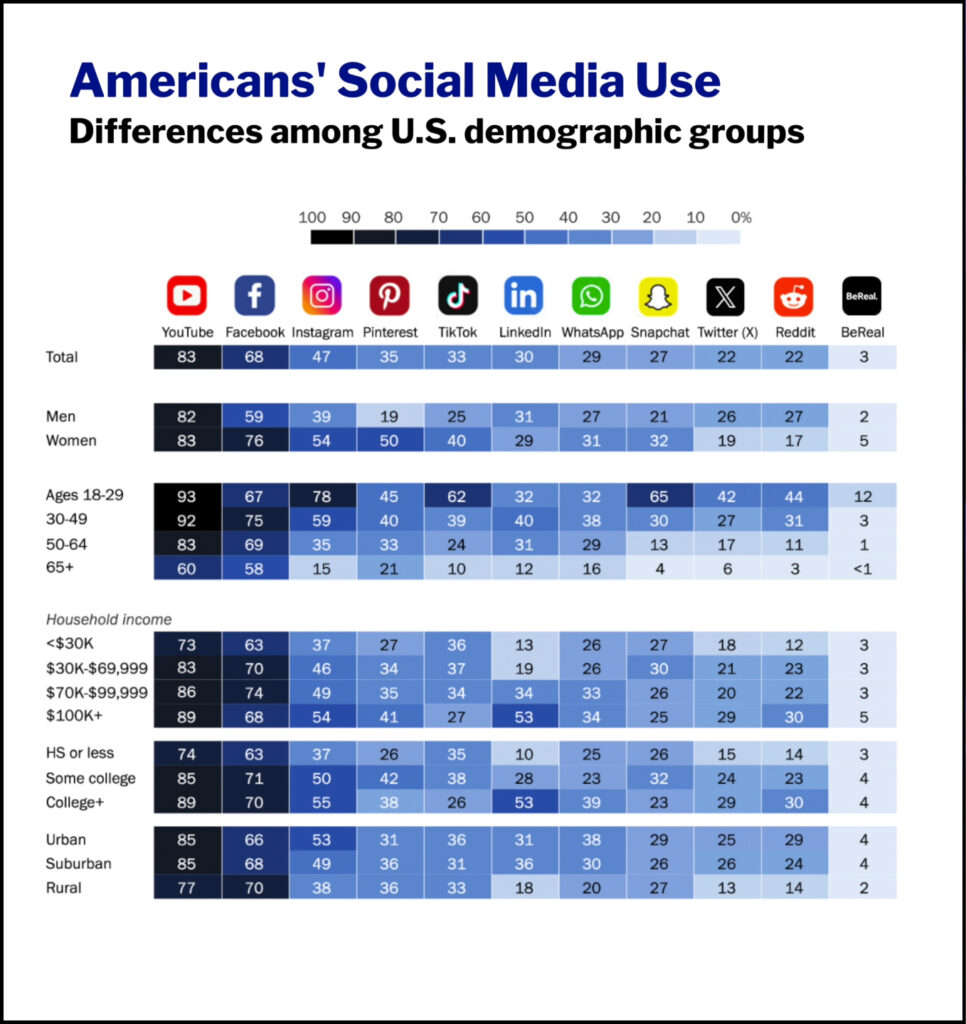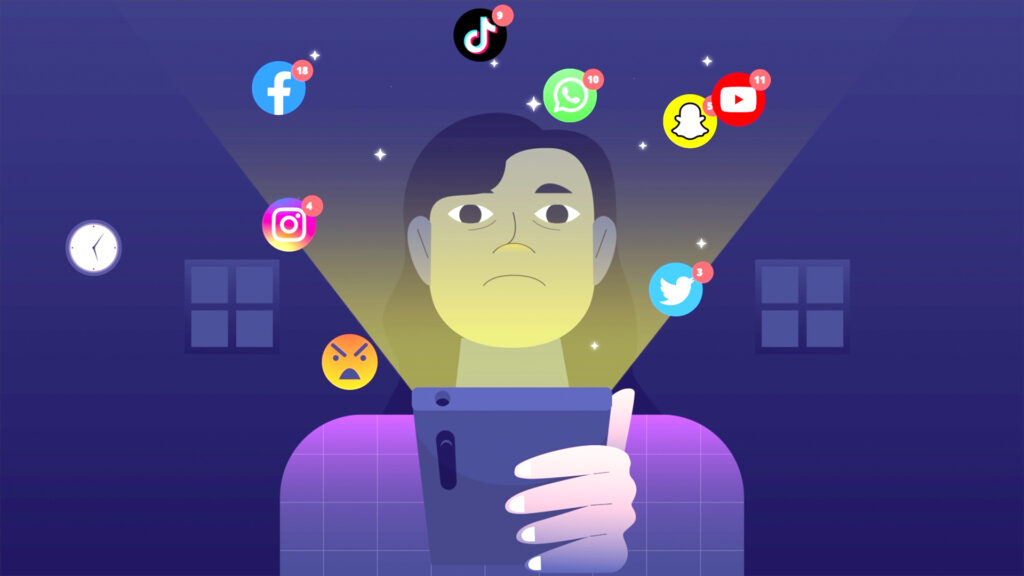4 MINUTE READ
Hotel marketers today are becoming far too dependent on Instagram to drive bookings. Here, we present the latest data from Pew Research on “Social Media Use among U.S. Adults” – and why it might be time to seriously reconsider your hotel’s marketing strategy.
Over the last year’s hotel conferences and trade shows, the relentless chatter around social media content was ever-present. As usual, the 80/20 principle applied, with about 80% of the marketing talks being devoted to Instagram tactics like influencer partnerships and short-form video. While the other 20% were taken up by 2023’s belle of the ball: A.I.. Meanwhile, tried and true marketing tactics from before the days of social media hype got almost no attention at all. Well-established concepts like market segmentation, guest experience, and even website design were being taken for granted – as if every hotel already had those bases covered.
Across the hospitality industry, we now see hotels of every category posting to Instagram with the frequency and finesse of a five-star resort. But for all of the creative energy and marketing budget that we pour into our hotel’s Instagram feeds, when’s the last time we stopped to determine whether that’s where most of our audience is actually searching for travel inspiration? Well, thankfully, Pew Research has just released their latest report on Social Media Use among U.S. Adults, and the numbers may surprise you.
Pew Research Statistics on Social Media 2024
To better understand the data, let’s take a quick look at how Pew Research conducted the survey. Between the months of May and September 2023, they surveyed over 5,000 U.S. adults and asked them a simple question:
Do you ever use any of the following social media apps?
- BeReal
- Snapchat
- TikTok
- X (Twitter)
- YouTube
Looking at the broad overview in the first chart provided, we can see that YouTube is the clear leader with 83% of respondents saying they use the app. Facebook follows in second, with 68%, and Instagram is third, with less than half of respondents saying they use the app, at 47%. So what does this tell us about how much we’re focusing on Instagram? We can clearly see here that there are other apps that perform better.
Moving on to the changes in these responses over time, we can see that YouTube has experiences significant growth over the last five years, with Facebook plateauing at around 67% or 68%. Instagram has enjoyed some growth over the last few years, but remains in a distant third place, with over half of respondents saying they never use the platform.
When we explore a demographic breakdown of the respondents in the survey, we can see that Instagram performs very well with the all-important 18-29 year-old set, and with the 30-49 year-old Millennials. However, YouTube remains, by far, the most dominant platform across all age groups – as well as income level, education and location.
The people here have spoken, and YouTube has emerged as clear winner among social media platforms. But in spite of this fact, it’s not uncommon to see even major luxury hotels focus all of their energy on Instagram and not even have a YouTube channel, never mind a YouTube ad strategy.
The people here have spoken, and YouTube has emerged as clear winner among social media platforms.
So, why has the topic of Instagram marketing continued to steal the spotlight over the last few years, in spite of plateauing growth and waning effectiveness for advertisers? As hotel marketers, why are we devoting 80% of our marketing efforts to a platform that more than half of American travelers don’t even use?
Well really, there are two main reasons:
Social Media Addiction
The first and most obvious reason: Addiction.
Let’s face it, most of us hotel marketers have some level of Instagram addiction, and it makes sense. The marketing profession is dominated by creative thinkers who love to keep up with the latest trends, and Instagram is definitely our favorite sandbox to play in. To the average marketer, the idea of creating clever eye-catching Instagram campaigns all day is a virtual dream come true. It helps us to feel comfortably busy at work, all while we get to express our inner artists. Then we get to wave around detailed reports filled with vanity metrics and meaningless buzzwords like impressions and engagement, all without having to draw a straight line to bookings.
And for all this valuable engagement that we get to boast about in our meetings with general managers, what is the experience actually like for today’s average Instagram user? I don’t know about you, but over the last few years, my Instagram and Facebook feeds have deteriorated into a tedious hellscape, oversaturated with sponsored content and poorly targeted ads for online courses, weird clothing brands, and strange novelty products.
And what about the quality of this so-called engagement that Instagram is generating for our hotels? We all seem to be operating from this idealized imaginary scenario, where travelers are eager to follow a bunch of different hotel accounts and then parachute into our lobbies to spend all their hard-earned vacation money right there on property. It would be nice if that’s how it worked, but that’s not how most people use the app.
We turn to our feeds when we’re bored, putting ourselves almost into a trance-like state, similar to flipping through TV channels or driving down a quiet highway. After a while, we learn to tune our all the ads and sponsored content to focus on our true interests.
You may think you’re making an impact with every Instagram post, but in reality, you’re just adding to the noise – putting up a bunch of forgettable billboards along an already overcrowded highway.
The Dominance of OTAs on Google and Metasearch
The second reason behind our over-reliance on Instagram and other social media platforms, is the fact that other digital marketing channels have become absolutely overrun by the big OTAs, who spend billions of dollars every quarter on pay-per-click advertising. I mean, good luck outbidding Expedia or Booking.com for the top results on Google – and the metasearch platforms are no cakewalk either.
We all know that the hotel marketing landscape has been utterly transformed over the last twenty years by new digital channels like Google, OTAs, and even social media. Despite all this change, the goal of every hotel operator has remained exactly the same – maximize profitability by optimizing RevPAR and minimizing operating costs.
Despite all this change, the goal of every hotel operator has remained exactly the same – maximize profitability by optimizing RevPAR and minimizing operating costs.

Why do you think the average hotel Finance Director is always at odds with the Marketing department? For all of the time and money we invest in planning Instagram campaigns, hiring full-time Social Media Coordinators, or working with outside marketing agencies; they’re tasked with monitoring real-time revenue while keeping operating costs as low as possible. If you’re brave enough to ask them to be honest with you, they’ll probably tell you that last Instagram campaign you did amounted to diddly squat on the income statement.
Conclusion
Deep down, we all know that generating more Instagram posts won’t keep the lights on. Only revenue can do that. And as the old saying goes, “If it doesn’t make dollars, it doesn’t make sense (cents)”.
So how do we solve this problem? How do we back off of our Instagram addiction and generate reliable revenue for our hotels? Well, we need to begin by going back to what has always worked in the past. We all need to close out our apps on occasion, roll up our sleeves, and do the hard work of old-school marketing. With so many different properties and selling points, we all need to do our own research on our target audience and find out where they’re actually looking for travel inspiration – and then meet them there.
Instagram is certainly a powerful platform for reaching travelers at the early stages of their booking journey, but that doesn’t make it the “end all, be all” for travel marketers. Let’s say you represent a golf resort. Well, then maybe Facebook is the place for you. Maybe you’re promoting a resort for families with young children. Then, TikTok is a great place. The important thing is that you focus on channels where you know these travelers are looking for inspiration, and stop trying to solve every different problem with the same old social media solution.
To learn more about YouTube advertising and other hotel marketing strategies, contact us here.
About Accommovision
We deliver results-driven imagery to ignite demand for hotels, resorts, and luxury properties. From breathtaking videos to targeted campaigns, we strategically empower you to captivate your audience and leave a lasting impression.
Our unique blend of creative prowess and technical proficiency ensures your visual content reaches travel customers at critical touchpoints along the booking journey – driving revenue growth to maximize your marketing investment. Elevate your image and stand out from the crowd.





